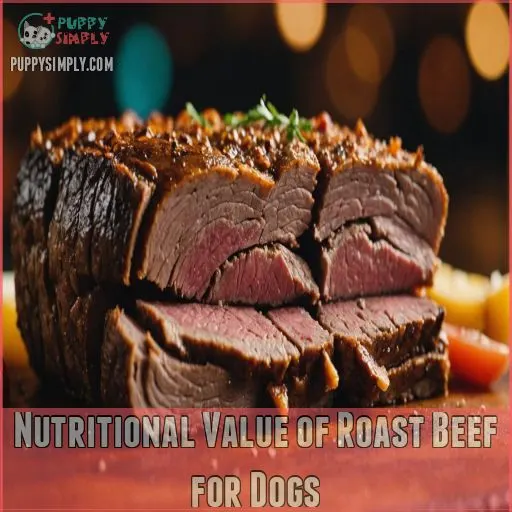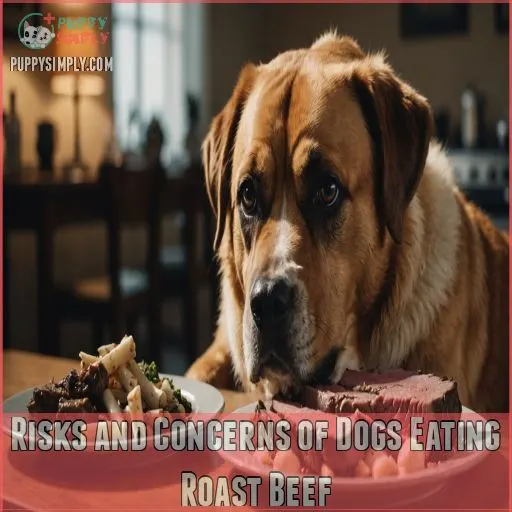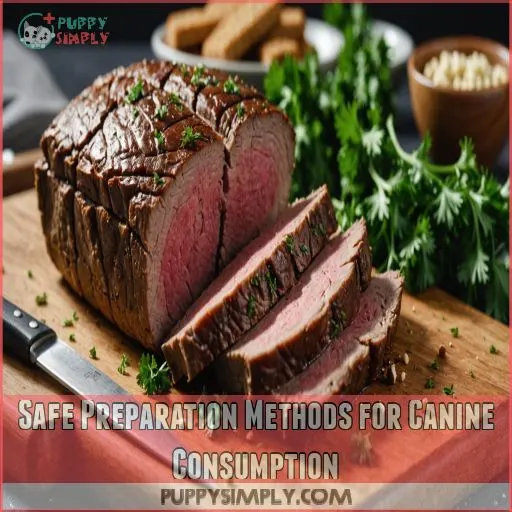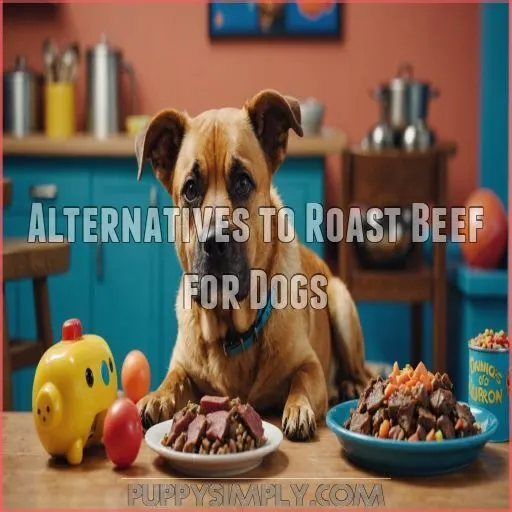This site is supported by our readers. We may earn a commission, at no cost to you, if you purchase through links.
 Can dogs eat roast beef? Absolutely, but there are a few things to keep in mind. While it’s a protein powerhouse packed with essential nutrients like iron and vitamin B12, moderation is key. Too much fat might leave your pooch feeling like a couch potato, or worse, trigger pancreatitis.
Can dogs eat roast beef? Absolutely, but there are a few things to keep in mind. While it’s a protein powerhouse packed with essential nutrients like iron and vitamin B12, moderation is key. Too much fat might leave your pooch feeling like a couch potato, or worse, trigger pancreatitis.
Watch out for sneaky seasonings, too; garlic and onions are a no-go. Opt for lean cuts and skip the salt for a dog-friendly feast. Trim it right and adjust portions to keep your dog’s tail wagging and tummy happy. Curious about more tasty tips? There’s plenty more to chew on next!
Table Of Contents
Key Takeaways
- Keep things simple when sharing roast beef with your dog: stick to lean cuts, watch the seasoning, and trim away extra fat. Remember, even though your dog’s not a food critic, a heart-healthy serving is still a happy serving.
- Roast beef can supercharge your pup’s muscles and energy, like giving them a turbo boost for squirrel-chasing. Just don’t overdo it, or you’ll have a couch potato instead of an exercise buddy.
- While you may be tempted to share the whole Sunday roast, bones and certain seasonings are a no-go zone. Think of them as the red flags your pup’s stomach wants you to heed.
- Some dogs, just like picky eaters at a buffet, might have allergies to beef. If your pup starts itching or looking uncomfortable post-roast beef, it might be time to try out some alternative proteins or a de-puffed vet visit.
Nutritional Value of Roast Beef for Dogs
You might be surprised to learn that roast beef can offer some nutritional benefits for your furry friend.
Let’s sniff out the facts about this meaty treat and see if it’s a tail-wagging addition to your pup’s diet or if you should keep it off their plate.
Protein Content in Roast Beef
Roast beef packs a punch when it comes to protein content for your furry friend, just like boiled chicken is a great source of protein for dogs. Here’s what you need to know:
- Beef protein vs. chicken: Higher iron content
- Protein sources: Roast beef is among the top
- Protein needs vary by breed: Large dogs need more
- Lean cuts are best for easy digestion
You’ll want to think about your pup’s specific needs when deciding if roast beef is the right protein source. Remember, moderation is key!
Essential Amino Acids for Canine Health
You’ve heard about protein, but let’s talk about the building blocks that make it special for your furry friend. Roast beef packs a punch with essential amino acids your dog needs. These tiny powerhouses fuel everything from muscle growth to a shiny coat.
Check out this breakdown of top amino acids in roast beef:
| Amino Acid | Function | Fun Fact |
|---|---|---|
| Leucine | Muscle builder | Helps your pup bounce back after playtime |
| Lysine | Immune booster | Keeps those pesky colds at bay |
| Methionine | Liver helper | Your dog’s natural detox buddy |
Fat Content and Its Effects on Dogs
Let’s chew the fat about roast beef and your furry friend. The fat content in roast beef can be a double-edged sword for dogs. While it provides essential fatty acids and energy, too much can lead to weight gain and health issues. Here’s the skinny on fat in your pup’s diet:
- Moderation is key – a little fat goes a long way
- Trim excess fat before serving to reduce calorie intake
- Opt for leaner cuts to keep your pooch’s waistline in check
Vitamins and Minerals Present in Roast Beef
Roast beef isn’t just tasty for your furry friend; it’s a powerhouse of nutrients.
Your pup can benefit from iron, which supports healthy blood, and vitamin B12 for nerve function.
Zinc helps maintain a shiny coat, while niacin aids digestion.
Don’t forget selenium – it’s great for your dog’s immune system.
Remember, these nutrients work together to keep your four-legged companion in top shape!
Potential Benefits of Feeding Dogs Roast Beef
You might be surprised to learn that roast beef can offer some benefits for your furry friend.
From promoting muscle health to giving your pup a shiny coat, let’s explore the potential perks of treating your dog to a bit of this savory meat.
Muscle Development and Maintenance
Fitness fanatics, take note! Your furry friend’s muscles need protein too. Roast beef packs a powerful punch for your pup’s muscle development and maintenance. It’s chock-full of essential amino acids that help build and repair canine muscle tissue.
Think of it as nature’s doggy gym supplement. But remember, balance is key – too much of a good thing can lead to unwanted weight gain.
Energy Boost for Active Dogs
Your active pup’s got a spring in their step, and roast beef might just be their secret weapon. Packed with protein, it’s like a turbo boost for high-energy breeds.
Imagine your furry friend chasing squirrels with newfound gusto!
Just remember, moderation is key. Use small pieces as training treats or mix them into their regular dog food. It’s a tail-wagging way to fuel their exercise routine without overdoing it.
Improved Coat and Skin Health
You’ve seen how roast beef can energize your pup, but did you know it’s also a secret weapon for coat and skin health?
The protein in roast beef packs a powerful punch, promoting a lustrous coat that’ll turn heads at the dog park.
Plus, those omega-3 fatty acids work wonders on dry skin, keeping your furry friend itch-free and comfortable. It’s like a spa day for your dog’s skin!
Palatability and Appetite Stimulation
Have you ever seen your furry friend’s eyes light up at the smell of roast beef? It’s no surprise – dogs find this meat irresistible. Roast beef can be a powerful appetite stimulant and flavor enhancer for your canine companion. Here’s why it’s such a hit:
- Intense aroma that triggers salivation
- Rich, meaty flavor that appeals to canine taste buds
- Tender texture that’s easy to chew and enjoy
- Versatility as a food topper or training treat
Risks and Concerns of Dogs Eating Roast Beef
While roast beef might seem like a tasty treat for your furry friend, it’s not all tail wags and happy barks.
You’ll want to know about the potential risks lurking in that juicy slice before sharing it with your pup.
High Sodium Content and Dehydration
While roast beef can offer nutritional benefits, it’s time to chew on a meaty concern: sodium overload.
That juicy slice might make your pup’s tail wag, but it’s packing a salty punch.
Too much sodium can leave Fido parched and potentially impact kidney function.
Keep an eye out for excessive thirst or unusual lethargy – these could be red flags for dehydration.
Always pair treats with plenty of fresh water!
Fat Content and Pancreatitis Risk
Indulging your furry friend with fatty roast beef might seem tempting, but it’s a risky move. High-fat meats can trigger pancreatitis in dogs, a painful inflammation of the pancreas.
Watch out for these warning signs:
- Vomiting and loss of appetite
- Hunched back or "praying position"
- Lethargy and abdominal pain
Stick to leaner cuts or beef alternatives to keep your pup’s pancreas happy. Remember, a little prevention goes a long way in avoiding costly vet bills!
Seasoning and Spice Toxicity
You might think those tasty seasonings make roast beef irresistible, but they’re a hidden danger for your furry friend. Common spices like garlic, onion, nutmeg, and even pepper can wreak havoc on your dog’s system.
Did you know cinnamon can cause liver damage in pups? It’s true! Your pooch’s sensitive nose might love the smell, but their body won’t thank you for these flavor-packed additions.
Choking Hazards and Digestive Issues
Beware of the hidden dangers lurking in that tempting slice of roast beef! Your furry friend’s enthusiasm might lead to trouble. Large chunks can become lodged in their throat, turning mealtime into a scary ordeal.
Even if they manage to gulp it down, their tummy might rebel. Tough pieces can be hard to digest, potentially causing stomach upset or even blockages.
It’s best to err on the side of caution and stick to dog-friendly portions.
Allergic Reactions in Sensitive Dogs
Seeing your dog suffer from allergic reactions is like watching a bad soap opera—unavoidable drama. Recognize signs of allergy in your pooch, like itching or upset tummy.
Common allergens in roast beef include:
- Beef proteins
- Additives
- Preservatives
Try home remedies, such as soothing baths, to ease discomfort. Prevention tips? Always check new foods cautiously!
Safe Preparation Methods for Canine Consumption
When preparing roast beef for your dog, focus on keeping it simple—ditch the spices, trim the fat, and cook it thoroughly.
Dogs aren’t food critics; they’re happy with plain, safe, and scrumptious beef that’s easy to chew!
Removing Excess Fat and Gristle
When serving roast beef to your furry friend, trim that extra fat and gristle.
Picture it as cleaning before a guest arrives: you wouldn’t leave clutter everywhere, right?
Fat trimming techniques help prevent dog health concerns like pancreatitis.
Gristle removal tips help make digestion easier.
Prioritizing these safe cooking methods keeps your pup’s meal healthy and enjoyable, especially when feeding your dog human foods.
Consider meat alternatives if needed!
Avoiding Seasoning and Spices
Steer clear of seasoning your pup’s roast beef with salt substitutes, garlic, onions, and certain herbs – these can be downright dangerous for dogs! Instead, opt for a simple, unseasoned preparation to keep your canine companion safe and healthy. Spice allergies are no joke, so it’s best to play it safe.
- Avoid salt substitutes containing potassium, as they can cause serious electrolyte imbalances.
- Garlic and onions are toxic to dogs, leading to anemia and other issues.
- Herbs like rosemary, thyme, and sage may seem harmless, but can upset sensitive stomachs.
- Spices like cayenne and chili powder can trigger allergic reactions in some dogs.
Proper Cooking Techniques for Dogs
Now let’s talk cooking! You’ve got the best intentions, but you don’t want your dog serenading the moon in gut distress.
Stick to safe cooking temperatures and remove bones.
Keep it simple with proper meat preparation methods.
Trust me, Fido won’t miss the spices!
Remember, good food safety practices keep wagging tails happy and healthy.
Bon appétit, pup style!
Appropriate Portion Sizes for Different Breeds
How much roast beef is too much? It depends on your dog’s size, weight, activity level, age, and breed factors. A teacup poodle won’t chow down like a burly Saint Bernard!
Aim for balance—too little leaves them hungry, too much risks pudginess.
Imagine portioning with Goldilocks’ precision: just right for their appetite and well-being! Remember, moderation’s key!
Alternatives to Roast Beef for Dogs
If your dog’s tired of the same old roast beef, or if you’re worried about its extra fat and sodium, it’s time to explore other tasty options.
From lean meats to veggie proteins, there’s a smorgasbord of alternatives that’ll keep your pup’s tail wagging and health in check.
Lean Meats Suitable for Canine Diets
Instead of roast beef, consider leaner meat options like chicken, turkey, or even ground bison. These protein-rich choices are easier on your pup’s digestive system and provide essential amino acids without the excess fat and sodium. You can even make your own homemade dog food recipes featuring these healthier meats.
- Chicken
- Turkey
- Bison
- Lean ground beef
- Pork tenderloin
Commercial Dog Foods With Beef Ingredients
While choosing lean meats is great, beef-based kibble offers a convenient option.
Premium brands often prioritize ingredient quality and provide grain-free options if needed.
Just keep an eye on beef byproducts—your dog deserves the best!
It’s like skipping the fast food drive-thru for a homemade meal.
Choosing responsibly helps to guarantee a healthy, wagging tail every day.
Homemade Beef-based Dog Food Recipes
DIY dog food can be a game-changer!
Try a simple beef-based recipe by combining cooked beef, brown rice, and veggies.
This recipe not only freshens up your pup’s diet, but also allows you to control every ingredient, ideal for avoiding dog food allergies.
Remember, your dog’s safety comes first, so steer clear of harmful spices and raw beef diets!
Vegetarian Protein Sources for Dogs
When whipping up homemade beef goodies, you might wonder about greener pastures.
Giving your pup vegetarian protein sources offers nutritious alternatives to beef.
Consider these:
- Lentils bring solid nutritional benefits—packed with protein and fiber.
- Tofu can be a delightful, healthy treat.
- Chickpeas make for an excellent, crunchy snack.
So, explore vegetarian dog food brands and vegan dog food recipes!
Frequently Asked Questions (FAQs)
Is roast beef suitable for puppies?
Sure, let’s feed a toddler spicy food.
Now, about roast beef for puppies—it’s not ideal. Puppies have delicate stomachs. Stick to puppy food and occasional plain meat treats to avoid a digestion rollercoaster. Your pup’s tummy will thank you!
How often can dogs eat roast beef?
You can feed your dog roast beef occasionally as a treat.
It shouldn’t make up more than 10% of their diet.
Moderation is key to avoid digestive issues or weight gain.
Can dogs eat roast beef with bones?
Keep Fido safe and avoid roast beef with bones.
Bones can splinter and cause blockages or injuries.
Give them a bone-free bite instead, ensuring a happy tail wag and peace of mind.
Who needs a vet visit, right?
Does roast beef affect dogs behavior?
Oddly enough, roast beef might make your dog act like they’ve won the lottery!
While most dogs love the taste, monitor their energy levels, as some might become overly excited or restless.
Moderation is the key to happiness.
Are certain dog breeds allergic to beef?
Certain breeds, such as Labradors and German Shepherds, often wrestle with beef allergies due to genetic predispositions.
It’s like playing Russian roulette with kibble—sometimes beef triggers an allergic reaction, leading to itchy, uncomfortable dogs (Source).
Conclusion
Ultimately, while roast beef can be a tasty treat for your canine companion, it requires careful consideration.
Moderation is key, and you must vigilantly monitor portion sizes, fat content, and potential seasonings.
By following these guidelines, you can safely incorporate the occasional roast beef morsel into your dog’s diet, ensuring their health and happiness, but remember to consult a veterinarian for advice on balanced nutrition for a raw diet for a balanced raw diet.
After all, can dogs eat roast beef? With the right approach, the answer is a resounding yes!











